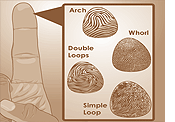|
Fingerprint Authentication SystemHow does fingerprint sensor (authentication) technology work?
First, one fingerprint image (or more) is registered on the device used to perform the authentication (e.g., a personal computer with integrated fingerprint scanner), and a template of the fingerprint is stored on a local database. When users want to log in, they must have their registered finger scanned again, and a second template is generated. Next, a pattern analysis is performed to determine if there is a match and if the logon should be allowed. The match is determined using points of interest (minutia) on the fingerprint, such as ridge bifurcations and ridge endings. If enough of the minutia points and vectors match, the fingerprint is considered a match and the logon is permitted. What are the basic types of fingerprint sensor technology in use today? Fingerprint sensors can use optical or capacitive technology. Each of these options suits different implementations. Like a digital camera, optical technology employs visible light to capture a digital image. It uses a light source to illuminate the finger's surface while a charge-coupled device (CCD) captures the image, which is then converted to a digital signal. There are two types of capacitive technologies: passive and active. Passive capacitive technology uses a silicon-based structure containing an array of plates that are used to apply a small electrical current and measure the voltage discharge through the finger when it is placed over the sensor. The plates act as a parallel array of capacitors when the finger is placed on the sensor, and the capacitance at each point (pixel) is measured. Fingerprint ridges have a substantially greater discharge potential than valleys containing air, which may have little or no discharge. In either case, the result is an 8-bit high-contrast gray-scale image
|

Articles | Resources | XML | Product & Solutions | Support & Community | Sitemap | Contact Us | About Us | Home






